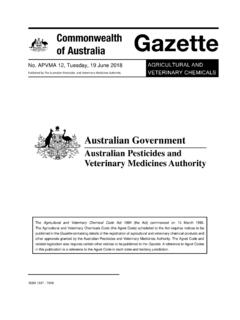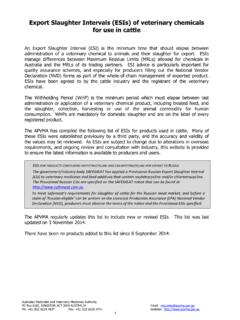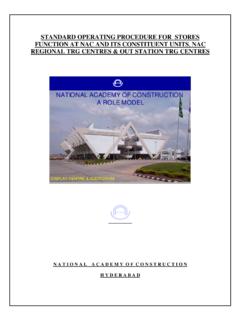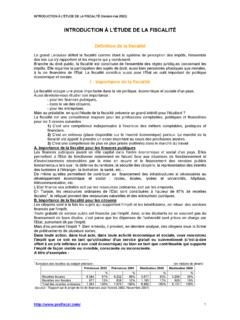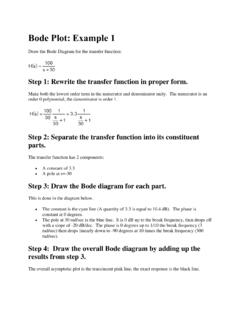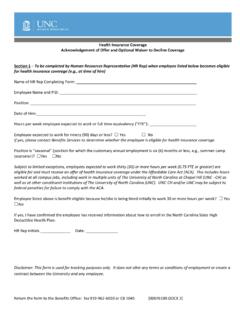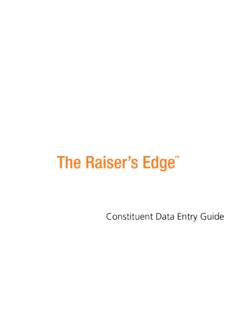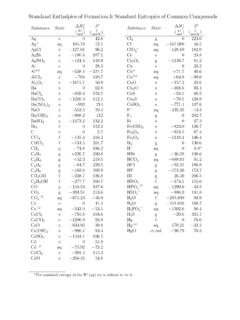Transcription of Guidelines for the validation of analytical methods
1 Guidelines FOR THE validation OF analytical methods FOR ACTIVE constituent , AGRICULTURAL AND VETERINARY CHEMICAL PRODUCTS October 2004 APVMA PO Box E240 KINGSTON 2604 AUSTRALIA : +61 2 6272 5852 Table of Contents Introduction_____3 Scope_____3 Data Requirements_____3 Parameters for Method Validation_____3 Selectivity (Specificity)_____3 Linearity_____4 Range_____4 Accuracy_____4 Precision_____5 Limit of Detection (LOD)_____6 Limit of Quantitation (LOQ)_____6 validation Characteristics and Requirements_____6 General Notes_____6 Regulatory analytical Methods_____6 Alternative analytical Methods_____7 Typical Characteristics for Nuclear Magnetic Resonance (NMR)
2 Data_____7 analytical Reference Standards_____7 Good Laboratory Practice_____7 Revalidation_____7 Definitions and Abbreviations_____8 References_____8 2 INTRODUCTION In order to generate the Part 2 Chemistry and Manufacture data for the approval of active constituents and registration of agricultural and veterinary chemical products, robust, accurate and precise analytical methods are required. methods are required for the identification, batch analysis, and storage stability data for active constituents and agricultural and veterinary chemical products, and for post-registration compliance purposes. SCOPE The objective of validation of an analytical method is to demonstrate that the procedure, when correctly applied, produces results that are fit for purpose.
3 These Guidelines describe the procedures to be carried out to validate the analytical procedures included as part of an application for approval of an active constituent and registration of an agricultural and veterinary chemical product, including those used in storage stability studies. They are not intended to apply to analytical methods for residue analysis, biological and biotechnological products. Approaches other than those set forth in this guideline may be acceptable provided they are supported by adequate scientific justification. In general, non-chromatographic analytical methods are not typically expected to comply with this guideline.
4 However, the APVMA may require that a non-chromatographic method demonstrate some form of validation in order to satisfy itself that the method is fit for purpose [ Nuclear Magnetic Resonance (NMR) methods are typically required to demonstrate certain validation parameters]. DATA REQUIREMENTS The following is a list of information that should typically be included in support of the adequacy of the analytical procedures: Method description this section should contain a full description of the analytical method. The description should include details of all-important operational parameters, such as sample preparation, including method of extraction of the active constituent from the product, details of the reference standards and reagents preparation.
5 Documentation confirming the purity of the reference materials should also be provided. validation data - all relevant data collected during validation should also be provided. Relevant data are considered to be: copies of chromatograms that are clearly labelled with peak identity and peak integration data; NMR spectra clearly showing chemical shifts and coupling constants; formulae and calculations used for calculating validation characteristics. PARAMETERS FOR METHOD validation To be fit for the intended purpose, the method must meet certain validation characteristics. Typical validation characteristics, which should be considered are: selectivity (specificity), linearity, range, accuracy, precision, limit of detection and quantitation.
6 Selectivity (Specificity) Selectivity of a method refers to the extent to which it can determine particular analyte(s) in a complex mixture without interference from other components in the mixture. The terms selectivity and specificity have often been used interchangeably. The term specific generally refers to a method that produces a response for a single analyte only, while the term selective refers to a method that provides responses for a number of chemical entities that may or may not be distinguished from each other. If the response is distinguished from all other responses, the method is said to be selective. Since very few 3analytical methods respond to only one analyte, the use of the term selectivity is more appropriate than specificity.
7 The International Union of Pure and Applied Chemistry (IUPAC) has expressed the view that Specificity is the ultimate of Selectivity . The IUPAC discourages use of the term specificity and instead encourages the use of the term selectivity. The selectivity of the analytical method must be demonstrated by providing data to show the absence of interference peaks with regard to degradation products, synthetic impurities and the matrix (excipients present in the formulated product at their expected levels). The selectivity of chromatographic methods may be assessed by examination of peak homogeneity or peak purity test ( , diode array, mass spectrometry) to show that the analyte chromatographic peak is not attributable to more than one component.
8 Linearity The linearity is the ability of analytical procedure to produce test results which are proportional to the concentration (amount) of analyte in samples within a given concentration range, either directly or by means of a well-defined mathematical transformation. Linearity should be determined by using a minimum of six standards whose concentration span 80 120% of the expected concentration range. The linearity of a method should be established by visual inspection of a plot of analytical response as a function of analyte concentration. If there is a linear relationship, test results should be evaluated by appropriate statistical methods , for example, by calculation of the regression line by the method of least squares.
9 In some cases, the test data may need to be subjected to a mathematical transformation prior to regression analysis. Reports submitted must include, the slope of the line, intercept and correlation coefficient data. The measured slope should demonstrate a clear correlation between response and analyte concentrations. The results should not show a significant deviation from linearity, which is taken to mean that the correlation coefficient, r > , over the working range (80 120%). If this is not the case ( r is < ), the submitter must provide an explanation of how accurate calibration is to be maintained. In cases where a non-linear response is deliberately used, an explanation must be provided.
10 Range The specified range is normally derived from the linearity studies. The range of an analytical procedure is the interval between the upper and lower concentration (amounts) of analyte in the sample for which it has been demonstrated that the analytical method has suitable levels of precision, accuracy and linearity. The following minimum specified ranges should be considered: For the assay of the active constituent or an agricultural/veterinary chemical product: normally from 80 120% of the test concentration/label concentration; and For the determination of an impurity: from the specification level of the impurity to 120% of the specification.
